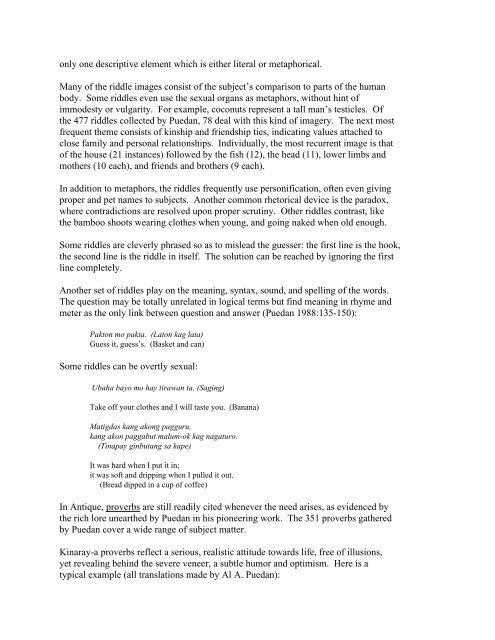Kinaray-a
Kinaray-a
Kinaray-a
Create successful ePaper yourself
Turn your PDF publications into a flip-book with our unique Google optimized e-Paper software.
only one descriptive element which is either literal or metaphorical.<br />
Many of the riddle images consist of the subject’s comparison to parts of the human<br />
body. Some riddles even use the sexual organs as metaphors, without hint of<br />
immodesty or vulgarity. For example, coconuts represent a tall man’s testicles. Of<br />
the 477 riddles collected by Puedan, 78 deal with this kind of imagery. The next most<br />
frequent theme consists of kinship and friendship ties, indicating values attached to<br />
close family and personal relationships. Individually, the most recurrent image is that<br />
of the house (21 instances) followed by the fish (12), the head (11), lower limbs and<br />
mothers (10 each), and friends and brothers (9 each).<br />
In addition to metaphors, the riddles frequently use personification, often even giving<br />
proper and pet names to subjects. Another common rhetorical device is the paradox,<br />
where contradictions are resolved upon proper scrutiny. Other riddles contrast, like<br />
the bamboo shoots wearing clothes when young, and going naked when old enough.<br />
Some riddles are cleverly phrased so as to mislead the guesser: the first line is the hook,<br />
the second line is the riddle in itself. The solution can be reached by ignoring the first<br />
line completely.<br />
Another set of riddles play on the meaning, syntax, sound, and spelling of the words.<br />
The question may be totally unrelated in logical terms but find meaning in rhyme and<br />
meter as the only link between question and answer (Puedan 1988:135-150):<br />
Pakton mo pakta. (Laton kag lata)<br />
Guess it, guess’s. (Basket and can)<br />
Some riddles can be overtly sexual:<br />
Ubaha bayo mo hay tirawan ta. (Saging)<br />
Take off your clothes and I will taste you. (Banana)<br />
Matigdas kang akong pagguru,<br />
kang akon paggabut malum-ok kag nagaturo.<br />
(Tinapay ginbutang sa kape)<br />
It was hard when I put it in;<br />
it was soft and dripping when I pulled it out.<br />
(Bread dipped in a cup of coffee)<br />
In Antique, proverbs are still readily cited whenever the need arises, as evidenced by<br />
the rich lore unearthed by Puedan in his pioneering work. The 351 proverbs gathered<br />
by Puedan cover a wide range of subject matter.<br />
<strong>Kinaray</strong>-a proverbs reflect a serious, realistic attitude towards life, free of illusions,<br />
yet revealing behind the severe veneer, a subtle humor and optimism. Here is a<br />
typical example (all translations made by Al A. Puedan):
















